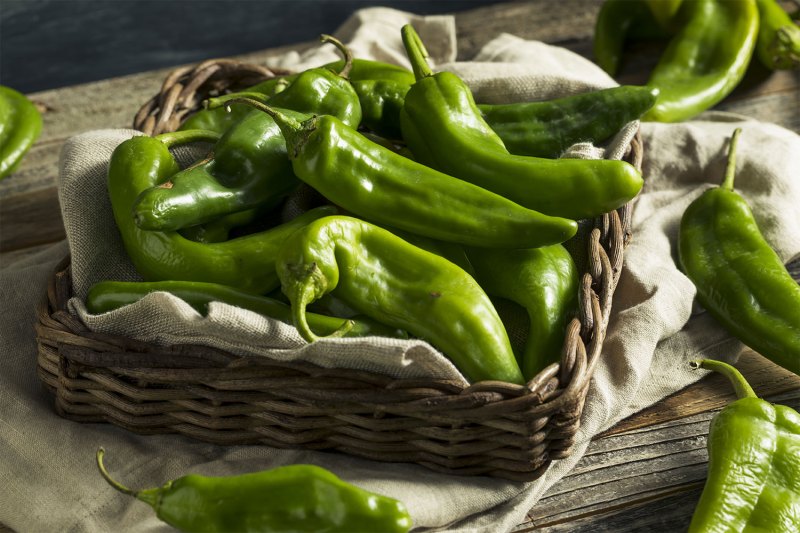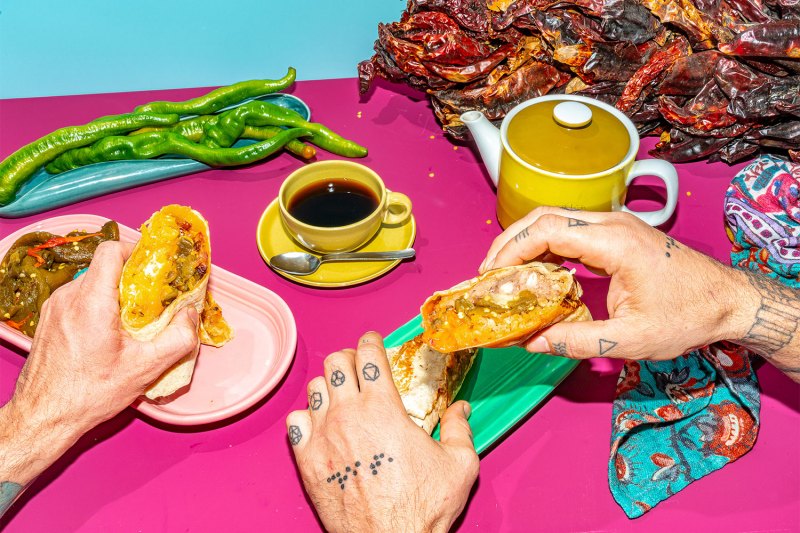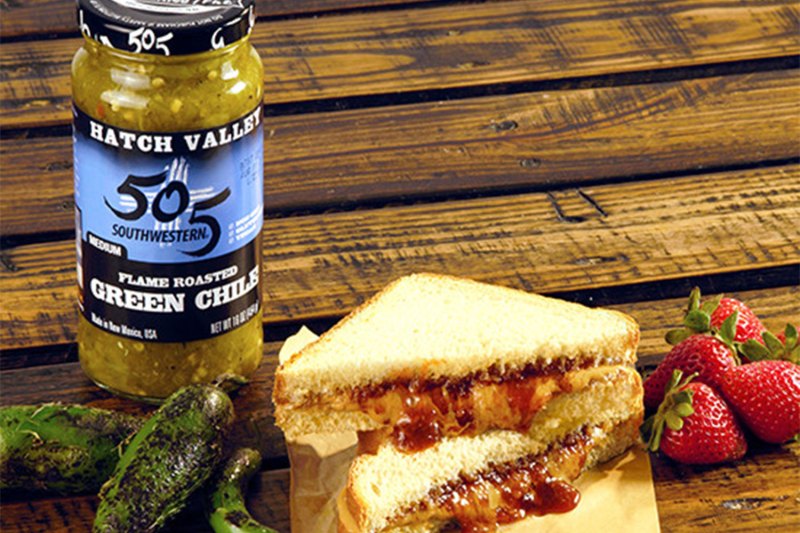The American Southwest has a long and rich history of capturing the imaginations of residents and visitors alike. Its vast desert vistas, its vibrant creative communities, its starring role in famous works of art ranging from Georgia O’Keeffe’s artworks to Breaking Bad…this region, which includes the states of Arizona and New Mexico, along with parts of Utah, Colorado, Kansas, Oklahoma, and Texas, is a top American travel destination for many excellent reasons, and its bold and flavorful cuisine certainly counts among them.

The most vital ingredient in Southwestern cuisine has to be New Mexico green chiles, a type of roasted hot peppers that finds its way into countless dishes and condiments throughout the area. But what defines a “New Mexico green chile,” and how can they be used to their fullest effect? To get these answers, we looked to a group of chefs and chile experts who hail from the Southwest to give us the full scoop on this local specialty.
What Are New Mexico Green Chiles?
“New Mexico green chiles” and “Hatch green chiles” are often used as interchangeable terms, and founder Nate Cotanch of Zia Hatch Chile Company is here to explain exactly what “Hatch chile” means: “The Hatch chile isn’t one type of pepper, but refers to the unique and special desert terroir of New Mexico’s Hatch Valley in which it is grown and harvested once per year. Within the Hatch Valley, many different strains of chile are grown to result in different heat levels, lengths, thicknesses, etc. In general, these strains offer a ton of (useful) flavor and versatility when compared to other hot peppers. A really hot strain of Hatch chile (such as the Lumbre, for example) will absolutely heat up your mouth, but it won’t ruin it and will complement the flavor of what you’re using it with rather than overpower it. The heat also tends to die down fairly naturally and quickly rather than lingering and possibly making you nauseous.”

While the “Hatch chile” title covers plenty of pepper varieties, “New Mexico green chiles,” as their name suggests, are green Hatch chiles that undergo a fire-roasting process. Owner Eric See of Ursula Cafe in Brooklyn, New York (a new restaurant specializing in New Mexico-inspired dishes, including a green-chile-loaded breakfast burrito) agrees that the “terroir” of New Mexico chiles plays a major role in their ultimate flavor and heat level, telling us that “New Mexican green chiles are thought of much like grapes are in different winemaking regions around the world, and they vary based on the terroir of where they are farmed. My favorite variety is Big Jim, a green chile with only a mild-medium spice, a rich sweetness and deep green color; I don’t care for a spice level that doesn’t allow you to take in all the sweet vegetal nuances of a peak-season Hatch pepper.” He also mentions that “California’s Anaheim peppers were birthed of Hatch green chiles and developed in Central New Mexico to be able to prosper and grow in Central and Southern California,” making Anaheim peppers a solid alternative to Hatch chiles if you have trouble finding the latter.
How Do Green Chiles Influence Southwestern Cuisine?
“There isn’t [a Southwestern cuisine] without New Mexico green chiles!” insists Eric See. “That’s a fact. While [New Mexico green chiles] were once relegated to New Mexican cuisine specifically, they’re now commonplace in Southwestern cuisine in Arizona, Colorado, Utah, and Texas, too.”
The fact that Hatch green chiles can only truly be grown in New Mexico stands out to owner/bar manager/distiller (and Albuquerque native) Weston Holm of Blue Clover Distillery in Scottsdale, Arizona as a key factor in the green chile’s importance to Southwestern cooking. “Green chile is in a food group all on its own. It carries characteristics of an actual spice and food bite when prepared and cooked with properly. They are completely different from any other pepper out there. Because of its diverse cooking nature and the fact that the actual chile speaks for itself, it has to have the right climate to carry the real flavors, which only New Mexico and the Southwest can provide,” he says.
According to Chef Eric Greenspan of 505 Southwestern (a green-chile-products company founded in Albuquerque and now based in Denver, Colorado), the limit to New Mexico green chile’s impact on Southwestern cuisine does not exist. “Southwestern cuisine is one of the truly original American cuisines and Hatch green chiles are the backbone of Southwestern cuisine. They really make everything taste better, and in New Mexico, they take that very literally. You’ll find everything from the expected green chile stews and enchiladas, to the less expected green chile pizzas and burgers, to the completely unexpected green chile donuts and milkshakes,” Greenspan tells us.
How To Roast Your Own Hatch Chiles
The char provided by open-flame roasting heightens the natural flavor of the Hatch chile and transforms it into the food item that New Mexico is so proud to call its own. Luckily, it’s a relatively easy process, as long as you can score a solid supply of fresh green chiles (either Hatch or Anaheim) and have access to a flame grill. Weston Holm is happy to talk you through it:
“Turn your grill on high; it has to have a flame. [Add the chiles to the heated grill and,] with tongs, turn them regularly until the outer shell turns almost brown/black. Then, remove [the chiles] put in a Ziploc bag while hot. This is the most important step, [also] known as “sweating the chiles.” This holds the smoke flavor in and lets it mature. Let the chiles cool down before refrigerating (this is the second most important step). Once fully cooled, remove the bag from the fridge and peel the roasted half-burnt shell off of the chiles, de-seed them, and remove the stem from the chile peppers. Once peeled, dice [the chiles] and enjoy them in an omelet, on a hamburger or pizza (a must), or as a topping for tacos.”
Holm also notes that roasted green chiles last really well in the freezer, for “up to a year” in properly sealed Ziploc bags.
Peanut Butter, Strawberry, and Green Chile Jelly Sandwich

(By Eric Greenspan, chef, 505 Southwestern, Denver, Colorado)
Sure, savory dishes like burritos and grilled cheeses can obviously benefit from the smoky heat of New Mexico green chiles. But Eric Greenspan likes to broaden his green chile horizons, and that commitment to creative thinking resulted in a just-weird-enough-to-work dish that’s as unexpected as it is flavorful: A peanut butter sandwich with green chile-strawberry jelly. “ My favorite ‘out-of-the-box usage [for New Mexico green chiles] is in a strawberry jam for a PB&J. The heat from the chiles pairs with the sweetness [of the strawberries] so well…it’s really amazing,” insists Greenspan.
Ingredients:
For the Strawberry-Green Chile Jelly:
- 12 oz fire-roasted Hatch green chiles (Greenspan uses 505 Southwestern Flame Roasted Green Chiles)
- 1.25 lbs strawberries, destemmed and quartered
- 1 cup cider vinegar
- ⅓ cup lemon juice
- 1 tsp chili powder
- 1 tsp salt
- 6 cups brown sugar
For the Sandwiches:
- 8 slices white bread
- 1 cup peanut butter
- 1 cup strawberry-green chile jelly
Method:
- To make the jelly, add all ingredients to a saucepot and cook over low heat until all liquid has evaporated, approximately 1 hour.
- Pour the jelly into a blender/food processor (or use an immersion blender) and blend until smooth. Allow to cool.
- To make the sandwiches, spread ¼ cup jelly and ¼ cup peanut butter on a slice of bread, then repeat until you have peanut butter and jelly on 4 slices.
- Cover the peanut-butter-and-jelly slices with plain slices and serve.



